I want to apologize for the month long hiatus, which I have taken from updating this blog. I am no doubt back from Turkey, but instead of giving an update at this time, I will leave that until later to keep the events in the order in which they happened.
The fourth day in Malatya left me wondering what I should do with myself for the 3 whole days, which I had to left to explore the city. Wanting to see ancient Malatya, currently called Battalgazi , I read in Lonely Planet that after a 15 minute bus ride to reach the town square. Once again, I joined everyone in walking to the dolmus otogar, from where I continued another few blocks to the otogar at which the Battalgazi bus was located. The bus itself was much older than the ones operated in Ankara, but they were still very comfortable and spacious. It cost me 40YKR or .4 YTL each way, which ended up being quite a deal for a 2.5 hour trip.
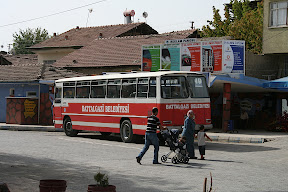
Upon finalizing my arrangements for my flight to Malatya, I had looked up what there was to do in Malatya. From the description in Lonely Planet, I envisioned a cute village that was basically abandoned with lush green grass growing everywhere. What it ended up being was nothing of the sort. The village itself seemed to be inhabited by many families who commuted into Malatya via the bus system to go to work. There were small groups of children roaming the streets while mothers performed chores at home. Instead of the lush green path ways, the streets were dusty and lined my houses coated in concrete. Down most of the street were empty lots containing the rubble left from whatever structure had previous stood there with knee high weeds growing through out. In almost every direction, you can see the evidence of the 29 towers that protected the city during medieval times. Upon arriving in Battalgazi, I walked over to the newly refurbished park in the center of the town square and sat down in the shade to consult Lonely Planet. Finally figuring out the directions to the three mosques of interest in this itty bitty town, I headed south of the square. A small group of boys scoped me out and started to follow me, presumably because I looked like a tourist with my camera.
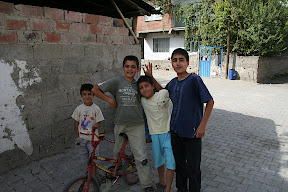
I first visited the Alacakapi mosque, which is located no more than 100 ft south of the square. It was constructed early on during the Ottoman empire with an inscription dating back to 1592* or 100 years after Columbus. Just past the mosque is an old caravan stop along the silk road constructed in 1637*. There is a small market located in the building these days. Trying the find the mosque of Ulu Camii , I started to roam the streets while picking up a larger pose of children. They quickly became disinterested as soon as I took their picture and assured them that I would not be giving them any money. This is all with the exception of one cute little boy. He didn't say a word while the other were begging and just tagged along. As soon as the rest of the boys peeled off, he asked me to follow him. While I had finally gotten back on track towards the mosque, it was still nice to have a little tour guide. He led me further down the main street leading south from the square and turned down a narrow street that was marked with an arrow towards the mosque. I would like to say that this was the first time in Turkey that I actually witnessed street signs of any form on an actual city street.

When we arrived at the Ulu Camii, I found the ruins of an old theological school by way of a sign giving it's history. It was constructed starting in 1303 and continued to operate through the 18th century. Turning around, the Ulu Camii is a more conservative looking mosque without the immense spires and stained glass windows. The conservatism of the architecture of the Ulu Camii and Alacakapi surprised me as the other mosques I had come across have intricate stone carvings and metal work covering their structures. With my little friend, I walked around the mosque taking pictures of the different architectural aspects, especially the alcoves that contained the doorways.
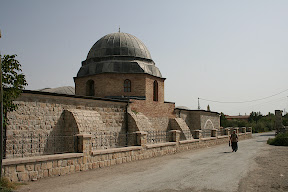
My little friend motioned for me to follow him again, so I tagged along. He took me to what Lonely Planet refers to as Ak Minare Camii, or the White Minaret Mosque. Where as Ulu Camii seemed deserted, Ak Minare Camii was more tranquil and seemed to be better taken care of. The architecture is much more similar to that of most other mosques you'll see in Turkey, especially with the minarets and stone work screens covering the windows. My little friend went to go drink water out one of the faucets about the courtyard. Not wanting to trespass, I decided to wait outside the gate. I would like to add that at no time during the trip did I ever get the feeling that visitors were not welcome in or around any of the mosques. In fact, I have read in Lonely Planet and elsewhere that visitng mosques is encouraged with the clerics being very accomidating even if they don't speak english. After seeing everything there was to see, my friend and I headed back towards the town square. He did try to get me to head towards one of the towers, but I was tired and just wanted to get back to the conference hall. Reaching the town square, I decided to pay my little tour guide with some cookies, so I visited the grocery store that's housed in the old caravan stop and bought a few cookies. Many of the kids started to surround me hoping that I would start handing them out, but I didn't make any motion to do so until he was the only one left around. As it so happened, he wouldn't take any of them, even though he had watched me buy them. I boarded the bus back to Malatya and saw out the window that my little friend was there to watch me leave. I started waving to him, and the bus finally pulled out of the station.
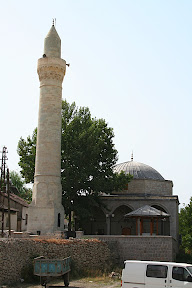
Upon reaching Malatya, I boarded a dolmus for the conference. After hanging out for a while, we decided to head downtown to see the museum. Since I had already seen it, I wasn't too thrilled but it was nice to get away from the conference center with my friends. We arrived at about 4:30pm and were informed that the museum closed in about 5 minutes. They convinced the guard to let us roam without charging us. We quickly checked out the exhibits, and everyone was happy that I had already photographed the whole museum. Upon leaving, we decided to check out the park adjacent to the museum. One of the many improvements made to Malatya was the recent addition of this park which doubled as a thoroughfare to a neighborhood to the south. Water was pumped to the top of a hill and flowed down stone block lined canals. We were standing at the foot of this hill where several fountains and water falls were located. It was a very relaxing place to be, especially on a hot day in August.
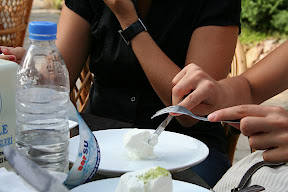
Investigating further up the hill, we discovered an ice cream shop. The ice cream made in Turkey is very different than that served in the western world. Dondurma, Turkish ice cream, is made with Salep and Mastic resin, which give it a more elastic and tougher texture than western ice cream. According to wikipedia, Salep is made from the ground tubers of an orchid, and is also used to make the drink of the same name (which I ended up having once I got back to Ankara). These ingredients also allow for higher melting temperatures which allows for easier vending on the streets. Dondurma vendors are easily recognized as they use paddles on long metal rods to churn the ice cream to keep it easily workable. In our case, the dondurma was made with a mold and cut off into cubes, which were then served on a plate with a fork and knife. With the temperature at around 90F that day, I was really surprised to see the ice cream stay solid while they were consuming it. Still being cautious, I only had a small taste of the dondurma. The taste was sweet and slightly milky but nothing extraordinary. I would definitely say that if you ever have the chance to eat dondurma you should. The texture and experience of eating it alone make it worth it even if the flavor isn’t necessarily memorable.

As Sertan and I were the only guys in our group of 6, we were persuaded to go stroll through the bazaar in search of shopping opportunities. I directed everyone to the section where I had encountered the coppersmiths the day before. We spent about 30 minutes in one of the shops where I ended up buying several copper pieces for my mother, two of my friends who were recently married, and myself. I had to be very careful to make sure everything was handmade as several of the pieces had manufacturer markings on the bottom. When asked, the shopkeepers were honest about which pieces were handmade (or at least to the best of my ability to tell).
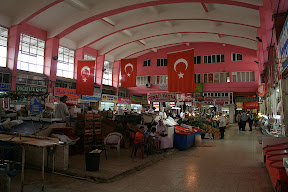
Wandering further through the bazaar, one could see the stalls, which sold freshly slaughtered meats, aged sausages, and chickens that have been rotisseried. One whole square block was dedicated to butcher shops. Other blocks contained other food related stores, including a large number of shops that sold a large array of spices. I think this is the one aspect of Turkey that I will greatly miss and regret not being able to take advantage of. With the sun starting to set, Tijen decided to head back to the university for the night. As the Canans had an extra bed in their room, Damla decided to stay out with us that night and crash at our guesthouse. Damla, Sertan, and I walked over to the mosque located in the center of the town to wait for Mert and Canan who had stayed at the conference to see a few talks. In the mean time, I decided that I wanted to learn how to properly wash myself outside the mosque to prepare for Muslim prayers. Even though Sertan had no clue how to do it, he offered to watch what other were doing and tell me what order to wash myself in. I will describe this later as I feel like it deserves proper attention in a more detailed fashion. During my attempt at learning how to properly washing myself, Mert and Canan arrived and Mert took a few pictures of me.
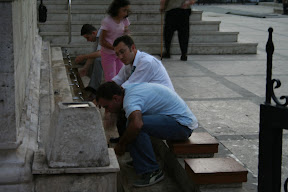
Everyone decided that dinner sounded like a good idea. Mert and Sertan had been craving Kokorich(sp?), a dish involving chicken intestines. I had this dish about a month and a half earlier and found it really good. Because all ther restaurants selling it smelled too much like raw meat for Canan to handle, we ended up eating at a semi-upscale place on the main street. Upon walking in, I got really excited because they advertised that they served kumpir, or baked potatoes.

After dinner, everyone wanted beer, so we ended up going back to the bar we found the first night. Once again after ordering drinks, we were served large plates of cantaloupe, honey dew melon, and grapes and nuts. After a few drinks, we all dragged ourselves back to the guest house where we all crashed. It had been a really long day…
* It occurs to me that the years posted on the signs, which I read and am heavily basing the posting on, are not based on the Christian calendar, which we use here in the US. (If I'm wrong about that, please correct me!)